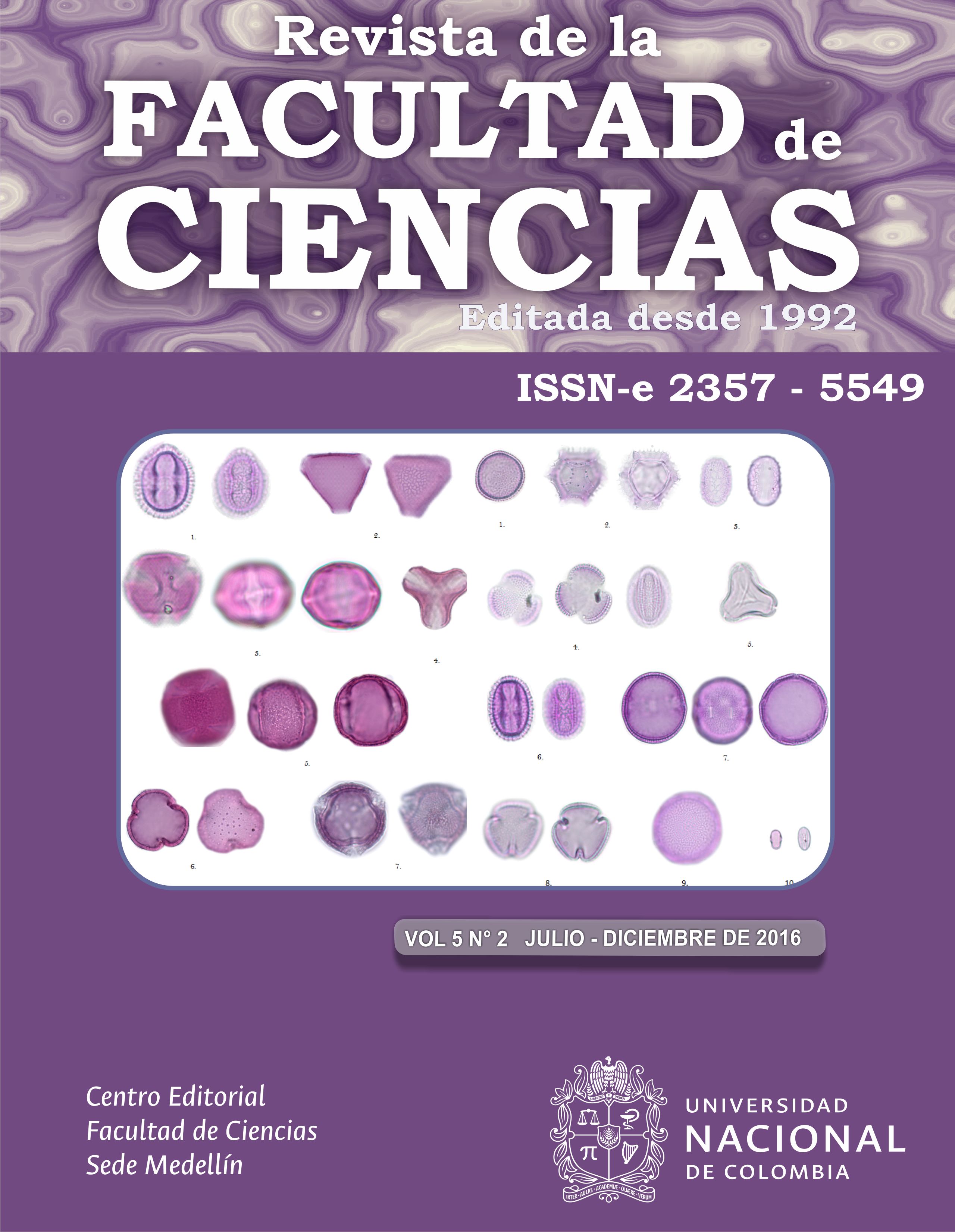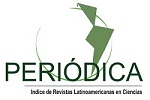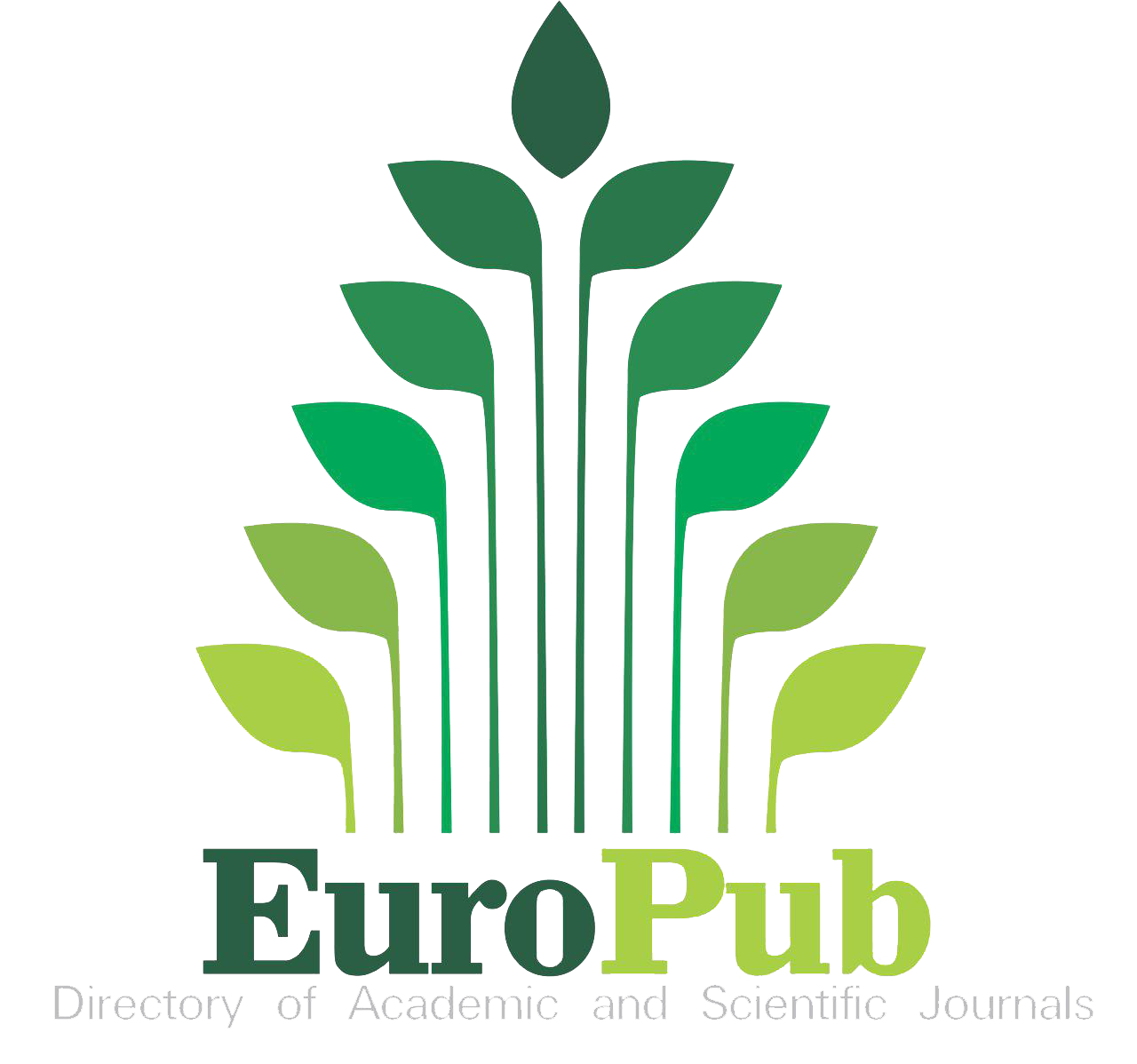Presencia de Wolbachia y Leishmania en una población de Lutzomyia evansi de la Costa Caribe de Colombia
Presence of Wolbachia and Leishmania in a population of Lutzomyia evansi from the Caribbean Coast of Colombia
DOI:
https://doi.org/10.15446/rev.fac.cienc.v5n2.56684Keywords:
ADN, Lutzomyia evansi, infección natural, Wolbachia, Leishmania (es)Colombia, Lutzomyia evansi, natural infection, Wolbachia, Leishmania (en)
Downloads
Lutzomyia evansi es importante en salud pública por su participación en la trasmisión de la leishmaniasis visceral y cutánea en la costa caribe de Colombia. Diversos estudios se han desarrollado sobre la poblaciones naturales de Lutzomyia evansi, sin embargo pocos estudios han explorado en profundidad la detección de microorganismos simbióticos (ej. Wolbachia) y de manera simultánea la presencia de Leishmania sp.. El endosimbionte Wolbachia ha sido propuesto en la actualidad como control biológico de insectos vectores de diversas enfermedades tropicales. En el presente estudio el ADN de tres especies del género Lutzomyia colectadas en el municipio de Ovejas (Departamento de Sucre) fue evaluado para detectar la infección natural por la bacteria Wolbachia y la presencia de parásitos del género Leishmania. El ADN total de 176 individuos adultos y 34 inmaduros (larvas y pupas) de Lu. evansi, fue utilizado para evaluar la detección de Wolbachia mediante amplificación por PCR del gen WSP (Proteína Mayor de la Superficie de Wolbachia) y la infección por Leishmania mediante amplificación por PCR de segmentos de los genes HPSN70 (Proteína de Choque Térmico). Se encontró un grupo de machos infectado de forma natural por Wolbachia y nueve grupos de hembras con infección natural por Leishmania, todos pertenecientes a Lutzomyia evansi. El análisis filogenético de la secuencia del gen WSP de Wolbachia indica la ubicación de la cepa detectada dentro del supergrupo B (haplogrupo wLeva) y su relación con haplotipos previamente reportados de Lutzomyia evansi y Lutzomya dubitans. Una región de 418 pb del gen HSP-70N fue secuenciada y mostró similaridad con secuencias de Leishmania luego de realizar el análisis en BlastN. Se confirma la presencia de Wolbachia en poblaciones silvestres de machos de L. evansi y la infección natural por Leishmania spp. en hembras de la misma especie cuya infección por Wolbachia resulto negativa.
References
Altschul, S., Madden, T., Schaffer, A., Zhang, J., Zhang, Z., Miller, W. & Lipman, D. (1997). Gapped BLAST and PSI-BLAST: a new generation of protein database search programs. Nucleic Acids Research, 25(17), 3389-3402.
Azpurua, J., De La Cruz, D., Valderama, A. & Windsor, D. (2010). Lutzomyia Sand Fly Diversity and Rates of Infection by Wolbachia and an Exotic Leishmania Species on Barro Colorado Island, Panama. PLOS Neglected Tropical Diseases, 4(3), e627.
Baldo, J., Hotopp, D., Jolley, K., Bordenstein, S., Biber, S., Choudhury, S., Hayashi, C., et al. (2006). Multilocus Sequence Typing System for the Endosymbiont Wolbachia pipientis. Applied and Environmental Microbiology, 72 (11), 7098-7110.
Blanco-Tuirán, P., Maingon. R., Hommel, M. & Alcalá, J. (1993). A focus of visceral and cutaneous leishmaniasis on the northern coast of Colombia. Archives de l'Institut Pasteur de Tunis, 70, 481-8.
Bejarano, E., Sierra, D. & Vélez, I. (2003). Novedades en la distribución geográfica del grupo verrucarum (Diptera: Psychodidae) en Colombia. Biomédica, 23(3), 341-350.
Bejarano, E. (2006). Lista actualizada de los psicodidos (Diptera: Psychodidae) de Colombia. Folia Entomológica Mexicana, 45(1) 47-56.
Braig, R., Zhou, W., Dobson, L. & O'Neill, S. (1998). Cloning and characterization of a gene encoding the major Surface protein of the bacterial endosymbiont Wolbachia pipientis. Journal of Bacteriology, 180(9), 2373-2378.
Bejarano, E., Uribe, S., Perez, A., Egurrola, J., Dib, J. & Porter, C. (2015). Nuevos hallazgos de flebotomíneos (Diptera: Psychodidae) en la Sierra Nevada de Santa Marta, Colombia. Acta biol.Colomb. doi.org/10.15446/abc.v20n1.45176.
Bejarano, E., Pérez-Doria, A., Paternina, E., Paternina-Gómez, M. & Martínez, L. (2012). Natural infection of Lutzomyia evansi (Diptera: Psychodidae) with Leishmania (Viannia) spp. in northern Colombia. Am J Trop Med Hyg. 87, 173.
Camacho, M., Caraballo, L., Barrios, H., Correa, I. & Figueroa, N. (1977). Kala-azar: un foco en el departamento de Sucre. Tribuna Médica, 56, 33-4.
Cazorla, D., Oviedo, M. & Vívenes, M. (2010). Redescripción de la quetotaxia del cuarto estadio larval de Lutzomyia evansi (Diptera: Psychodidae, Phlebotominae). Revista Colombiana de Entomología, 36(1), 76-81.
Christensen, H., Herrer, A. & Telford, S. (1972). Enzootic cutaneous leishmaniasis in eastern Panama. II. Entomological investigations. Annals of Tropical Medicine and Parasitology, 66, 55-66.
Contreras, A., Vivero, R., Bejarano, E., Carrillo, L. & Vélez, I. (2012). Nuevos registros de flebotominos (Diptera: Psychodidae) en el área de influencia del río Amoyá en Chaparral, Tolima. Biomédica, 32(2), 263-268.
Cochero, S., Anaya, Y., Días, Y., Paternina, M., Luna, A., Paternina, L. & Bejarano, E. (2007). Infección natural de Lutzomyia cayennensis cayennensis con parásitos tripanosomastídeos (Kinetoplastida: Trypanosomatide) en los Montes de María, Colombia. Revista Cubana de Medicina Tropical, 61(3) 59-66.
Collins, F., Mendez, M., Rasmussen, M., Mehaffey, P., Besansky, N. & Finnerty, V. (1987). A ribosomal RNA gene probe differentiates member species of the Anopheles gambiae complex. The American Journal of Tropical Medicine and Hygiene, 37(1), 37-41.
Cortés, L. & Fernández, J. (2008). Especies de Lutzomyia en un foco urbano de leishmaniasis visceral y cutánea en El Carmen de Bolívar, Bolívar, Colombia. Biomédica, 28, 433-40.
Dedeine, F., Ahrens, M., Calcaterra, L. & Shoemaker, D. (2005). Social parasitism in fire ants (Solenopsis spp): a potential mechanism for interspecic transfer of Wolbachia. Molecular Entomology, 14, 1543-1548.
Ellegaard, M., Klasson, L., Naslund, K., Bourtzis, K. & Andersson, S. (2013). Comparative genomics of Wolbachia and the bacterial species concept. PLoS Genet, 9(4), e1003381. doi:10.1371/journal.pgen.1003381.
Floate, K., Kyei-Poku, G. & Coghlin, P. (2006). Overview and relavance of Wolbachia bacteria in biocontrol researsh. Biocontrol Science Technology, 16(8), 767-788.
Favia, G., Ricci, I., Damiani, C., Raddadi, N., Crotti, E., Marzorati, M., et al. (2007). Bacteria of the genus Asaia stably associate with Anopheles stephensi, an Asian malarial mosquito vector. Proc Natl Acad Sci USA. 104, 9047-9051.
Finney, C., Kamhawi, S. & Wasmuth, J. (2015). Does the Arthropod Microbiota Impact the Establishment of Vector-Borne Diseases in Mammalian Hosts?. Plos DOI: 10.1371/journal. ppat.1004646.
Fraga, J., Montalvo, A., De Doncker, S., Dujardin, J. & Auwera, G. (2010). Phylogeny of Leishmania species based on the heat shock protein 70 gene. Infection, Genetics and Evolution, 10(2), 238-45.
González, C., Cabrera, O., Munstermann, L. & Ferro, C. (2006). Distribución de los vectores de Leishmania infantum (Kinetoplastida: Trypanosomatidae) en Colombia. Biomédica, 26(supl.1), 64-72.
González, E. & Martínez, F. (2010). Consecuencias evolutivas causadas por bacterias del género Wolbachia en artrópodos. Boletín de la Sociedad Entomológica Aragonesa, 46, 189-202.
Gomes, M., de Medeiros. M., Silva. J., Tavares. J., Alves. M. & Freire, M. (2016). Sand flies (Diptera, Psychodidae, Phlebotominae), vectors of Leishmania protozoa, at an Atlantic Forest Conservation Unit in the municipality of Nísia Floresta, Rio Grande do Norte state, Brazil. Parasites & Vectors, 9, 83.
Hall, T. (1999). BioEdit: a user-friendly biological sequence alignment editor and analysis program for Windows 95/98/NT. Nucleic Acids Symposium Series, 41, 95-98.
Hernández, J., Hurtado, A., Ortiz, R. & Walschburger, T. (1992). Unidades biogeográficas de Colombia. Págs. 105-152 en: Halffter, G. (ed.). La Diversidad Biológica de Iberoamérica I. CYTED-B Programa iberoamericano de ciencia y tecnología para el desarrollo. Instituto de Ecología, A.C., Xalapa, México.
Higgins, D., Bleasby, A. & Fuchs, R. (1992). CLUSTAL V: improved software for multiple sequence alignment. Comput Appl Biosci. 8, 189-191.
Hoffmann, A., et al. (2011). Successful establishment ofWolbachia in Aedes populations to suppress dengue transmission. Nature, 476, 454-457.
Hoffmann, A., Ross, P.n & Rasic, G. (2015). Wolbachia strains for disease control: ecological and evolutionary considerations. Evolutionary Applications doi:10.1111/eva.12286. 8, 751-768.
Holdridge, L. (1967). Life Zone Ecology. San José (Costa Rica): Tropical Science Center.
Kittayaponga, P., Milnea, J., Tigvattananontb, S. & Baimaia, V. (2000). Distribution of the Reproduction-modifying Bacteria, Wolbachia, in Natural Populations of Tephritid Fruit Flies in Thailand Pattamaporn Kittayapong. Journal of the Science Society of Thailand, 26, 93-103.
Le Pape, P. (1992). Écoépidémiologie de la leishmaniose a Leishmania infantum = L. chagasi dans la plaine des caraibes (Colombie): corrélation vecteur et réservoir canin. [Montpellier, Francia]: Université de Montpellier I.
Librado, P. & Rosas, J. (2009). DnaSP v5: A software for comprehensive analysis of DNA polymorphism data. Bioinformatics, 25, 1451-145.
Luyo-Acero, G., Uezato, H., Oshiro, M., Takei, K., Kariya, K., Katakura, K., et al. (2004). Sequence variation of the Cytochrome b gene of various human infecting members of the genus Leishmania and their phylogeny. Parasitology, 128, 483-491.
Martin, D., Williamson, C. & Posada, D. (2005). RDP2: recombination detection and analysis from sequence alignments. Bioinformatics, 21(2) 260-262.
Martínez, L., Rebollo, J., Luna, A., Cochero, S. & Bejarano, E. (2010). Molecular identication of the parasites causing cutaneous leishmaniasis on the Caribbean coast of Colombia. Parasitology, 106, 647-652.
Montoya-Lerma, J. & Lane, R. (1996). Factors affecting host preference of Lutzomyia evansi (Diptera: Psychodidae), a vector of visceral leishmaniasis in Colombia. Bulletin of Entomological Research, 86 (1), 43-50.
Ono, M., Braig, H., Munstermann, L., Ferro, C. & Ot' Neill, S. (2001). Wolbachia Infections of Phlebotomine Sand Flies (Diptera: Psychodidae). J Med Entomol, 38(2), 237-241.
Paternina-Gómez, M., Pérez-Doria, A., Paternina, L., Velbel, D., Martínez, L. & Bejarano, E. (2011). Infección natural de Lutzomyia micropyga con tripanosomatídeos en el Caribe Colombiano. Biomédica, 31(sup.3), 209-421.
Paternina, L. (2012). Determinación molecular de las fuentes alimenticias de Lutzomyia spp. (Diptera: Psychodidae) asociadas a casos de Leishmaniasis Cutanea en el departamento de Sucre, Caribe Colombiano [tesis de maestría]. [Medellín (Colombia)]: Facultad de Ciencias, Universidad Nacional de Colombia Sede Medellín. p. 70.
Pérez-Doria, A., Paternina, L., Paternina, M., Martínez, L., Verbel-Vergara, D. & Bejarano E. (2011). Infección natural de Lutzomyia evansi con especies del complejo Leishmania braziliensis causantes de leishmaniasis cutánea en la Costa Caribe Colombiana. Biomédica, 31(3), 23-205.
Robert, E. (2004). MUSCLE: multiple sequence alignment with high accuracy and high throughput. Nucleic Acids Research, 32(5), 1792-97.
Rodriguero, Marcela, S. (2013). Wolbachia, una pandemia con posibilidades. Revista de la Sociedad Entomológica Argentina, 72, 3-4.
Ruang-Areerate, T., Kittyapong, P., Baimai, V. & O'Neill, S. (2003). Molecular Phylogeny of Wolbachia Endosymbionts in Southeast Asian Mosquitoes (Diptera: Culicidae) based on WSP gene sequences. Journal of Medical Entomology, 40(1), 1-5.
Rodríguez, N., Aguilar, C., Barrios, M. & Barker, D. (1999). Detection of Leishmania braziliensis in naturally infected individual sandflies by polymerase chain reaction. Trans R Soc Trop Med Hyg. 93, 47-49.
Sinkins, S. P., Walker, T., Lynd, A. R., Steven, A. R., Makepeace, B. L., Godfray, H. C. J., & Parkhill, J. (2005). Wolbachia variability and host eects on crossing type in Culex mosquitoes. Nature, 436(7048), 257-260.
Sanchez, I., Liria, J. & Feliciangeli, M. (2015). Ecological niche modeling of seventeen sandflies species (Diptera, Psychodidae, Phlebotominae) from Venezuela. International Journal of Zoology. http://dx.doi.org/10.1155/2015/108306.
Tamura, K., Dudley, J., Nei, M. & Kumar, S. (2007). MEGA 4.1: Molecular Evolutionary Genetics Analysis (MEGA) software version 4.0. Molecular Biology and Evolution, 24, 1596-1599.
Vívenes, M., Oviedo, M.& Márquez, J. (2005). Desarrollo de Lesihamania mexicana y Lesihmania amazonensis en Lutzomyia evansi (Diptera: Psychodidae, Phlebotomine). Revista Colombiana de Entomología, 31(1), 71-74.
Vivero, R., Ortega, E., Aparicio, Y., Torres, C., Muskus, C. & Bejarano, E. (2013). Flebotominos adultos e inmaduros (Diptera: Psychodidae): registros para el Caribe colombiano. Boletín de Malariología y Salud Ambiental, 3(2), 1-10.
Vivero R., Torres-Gutiérrez C., Bejarano E., Cadena H., Estrada L., Florez F., et al. (2015) Study on natural breeding sites of sand flies (Diptera: Phlebotominae) in areas of Leishmania transmission in Colombia. Parasit Vectors, 8 (116). doi: 10.1186/s13071-015-0711-y.
Vivero, R., Cadavid-Restrepo, G., Uribe, S., Moreno, C. & Vélez, I. (2016). Bacterial communities associated with the digestive tract of wild populations of Lutzomyia evansi: a vector of Leishmania in Colombia. Parasite. DOI: 10.1051/parasite/2016051. 23, 32.
Wallace, H. (2013). Mosquitos genéticamente modificados: preocupaciones actuales. Enang (Malasia): Third World Network. P. 98
Walker, T., Johnson, P., Moreira, L., Iturbe, I., Frentiu, F., McMeniman, C., et al. (2011). The wMel Wolbachia strain blocks dengue and invades caged Aedes aegypti populations. Nature, 476, 450-453.
Werren, J., Zhang, W. & Guo, L. (1995). Evolution and phylogeny of Wolbachia: reproductive parasites of arthropods. Proceedings of the Royal Society of London. Series B, 261, 55-63.
Werren, J. (1997). Biology of Wolbachia. Annual Review of Entomology, 42, 587-609.
Werren, J., Baldo, L.& Clark, M. (2008). Wolbachia: master manipulators of invertebrate biology. Nature Reviews Microbiology, 6, 741-751.
Young, G. & Duncan, M. (1994) Guide to identication and geographic distribution of Lutzomyia sand flies in Mexico, the West Indies, Central and South America (Diptera: Psychodidae). Mem. Am. Entomol. 54, 1-881.
Zambrano, P. (2014). Leishmaniasis. CIUDAD: Instituto Nacional de Salud. Protocolo de Vigilancia en Salud Pública PRO-R02.016-Versión 01.
Zhou, W., Rousset, F. & O'Neill, S. (1998). Phylogeny and PCR-based classication of Wolbachia strains using WSP gene sequences. Proceedings of the Royal Society of London. Series B, 265, 509-515.
How to Cite
APA
ACM
ACS
ABNT
Chicago
Harvard
IEEE
MLA
Turabian
Vancouver
Download Citation
CrossRef Cited-by
1. Maira Alemán-Santos, German Arrieta, Salim Mattar, Luis E. Paternina. (2024). Molecular screening of heritable bacterial endosymbionts in South American sandflies from northern Colombia. International Journal of Tropical Insect Science, 44(6), p.3057. https://doi.org/10.1007/s42690-024-01397-0.
Dimensions
PlumX
Article abstract page views
Downloads
License
Copyright (c) 2016 Revista de la Facultad de Ciencias

This work is licensed under a Creative Commons Attribution 4.0 International License.
The authors or copyright holders of each paper confer to the Journal of the Faculty of Sciences of Universidad Nacional de Colombia a non-exclusive, limited and free authorization on the paper that, once evaluated and approved, is sent for its subsequent publication in accordance with the following characteristics:
- The corrected version is sent according to the suggestions of the evaluators and it is clarified that the paper mentioned is an unpublished document on which the rights are authorized and full responsibility is assumed for the content of the work before both the Journal of the Faculty of Sciences, Universidad Nacional de Colombia and third parties.
- The authorization granted to the Journal will be in force from the date it is included in the respective volume and number of the Journal of the Faculty of Sciences in the Open Journal Systems and on the Journal’s home page (https://revistas.unal.edu.co/index.php/rfc/index), as well as in the different databases and data indexes in which the publication is indexed.
- The authors authorize the Journal of the Faculty of Sciences of Universidad Nacional de Colombia to publish the document in the format in which it is required (printed, digital, electronic or any other known or to be known) and authorize the Journal of the Faculty of Sciences to include the work in the indexes and search engines deemed necessary to promote its diffusion.
- The authors accept that the authorization is given free of charge, and therefore they waive any right to receive any emolument for the publication, distribution, public communication, and any other use made under the terms of this authorization.
- All the contents of the Journal of the Faculty of Sciences are published under the Creative Commons Attribution – Non-commercial – Without Derivative 4.0.License
MODEL LETTER OF PRESENTATION and TRANSFER OF COPYRIGHTS
Personal data processing policy
The names and email addresses entered in this Journal will be used exclusively for the purposes set out in it and will not be provided to third parties or used for other purposes.





















